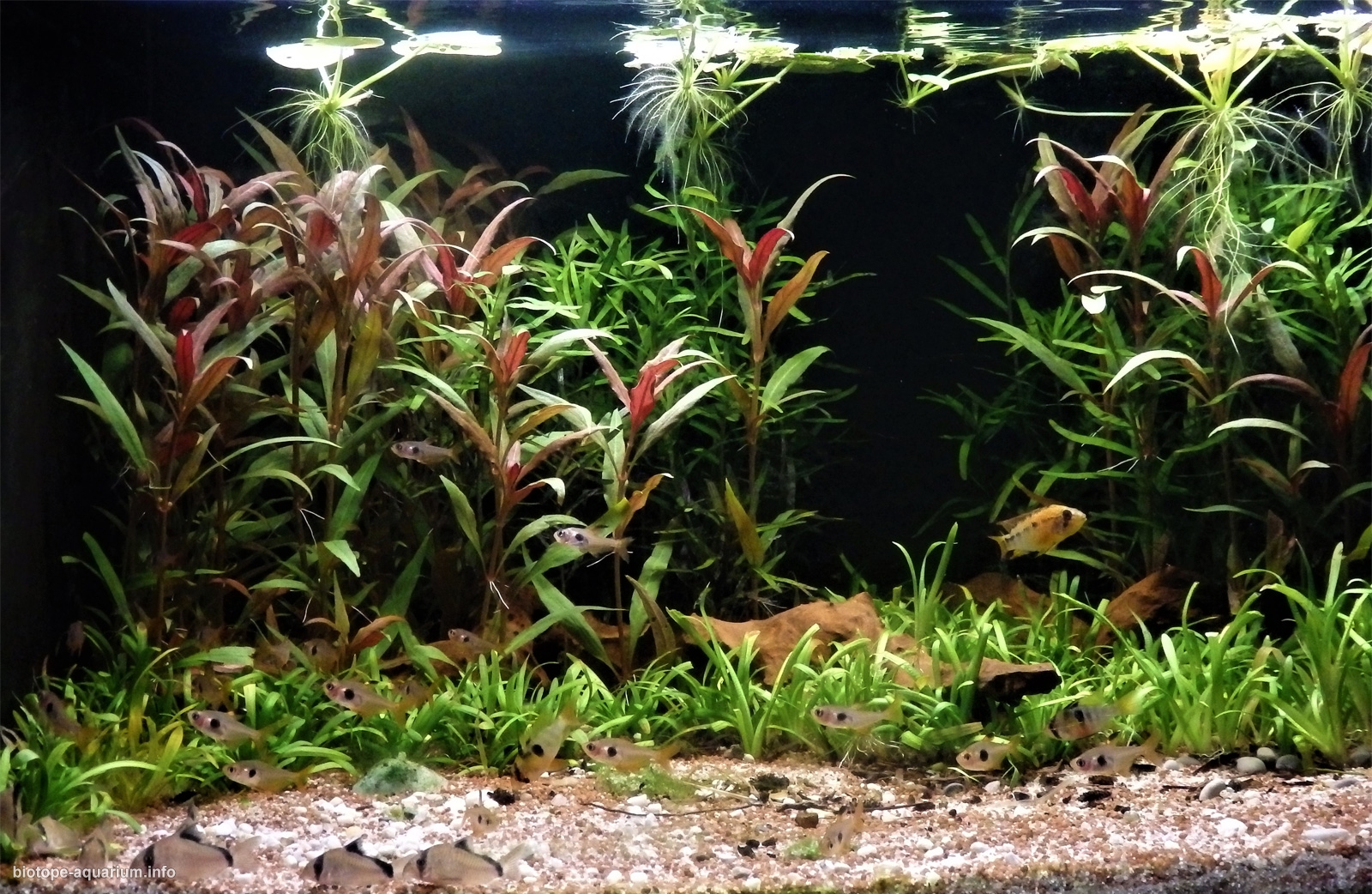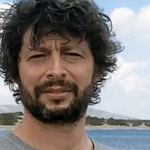Heavily planted area of an upper Rio Meta affluent, Colombia
53rd place in Biotope Aquarium Design Contest 2017
![]() Belgium. Jeroen Vanhooren
Belgium. Jeroen Vanhooren

Volume: 100 L
Dimensions: 70x33x50 cm
List of fishes: Hyphessobrycon sweglesi, Corydoras metae, Mikrogeophagus ramirezi, Apistogramma viejita
List of plants: Sagittaria subulata, Eichhornia diversifolia, Alternanthera reineckii and Limnobium laevigatum
Description of decorations: I used mainly sand (beige mixed with some darker grains), a handfull of gravel from different sizes and a little organic debris. Decoration was limited to a few pieces of old driftwood.
Description of equipment: internal sump, Juwel Eccoflow 600 lph, LED lights 28W 6800 K, automatic waterchange system with dripping technology.
Water parameters: pH 6, kH 2, temperature 27°
Description of the area surrounding the biotope: Rio Meta is a white water left tributary of the Rio Orinoco in Eastern Colombia and southern Venezuela. It originates in the Eastern ranges of the Andes and flows through the Meta department to Puerto Carreño, where it has its confluence with Orinoco. It flows east-northeastward across the Llanos Orientales. Meta river is 804 km long and its drainage basin is 93,800 square kilometres. Meta divides Colombian Llanos in a western humid nutrient rich part (due to the sediments from the Andean mountains) and the eastern part that drains tot he Orinoco with a longer dry season and nutrient poor surface waters. Although rather rare in this area, this biotope is a clearwater biotope.
Description of the underwater landscape of the biotope: Substrate mainly is fine sand with some dark grained aggregates, fine gravel that are typical for of many streams draining the eastern slopes of the Andes. Some old driftwood occurs, since many trees had been cut. There are some rocky areas, but they were not used in this biotope tank.
Description of the parameters of the habitat: Water is transparent. Temperature is 26-28°C. pH 4,5-6,5. Conductivity never higher than 100 µS/cm.
List of fishes: Hyphessobrycon sweglesi, Nannostomus eques, Nannostomus marginatus, Copella metae, Moenkhausia sp., Hemigrammus sp., Aphyocharax erythrurus, Astyanax metae, Thoracocharax stellatus, Iguanodectes spilurus, Apistogramma viejita, Mikrogeophagus ramirezi, Corydoras metae, Corydoras cf. mellini, Otocinclus sp., Rineloricaria sp., Ancistrus sp. (hoplogenys type),…
List of plants: Eichhornia sp. (most probably diversifolia), Alternanthera reineckii, different Echinodorus sp., Sagittaria subulata, Cabomba caroliniana, Limnobium laevigatum,…
Threats to the ecology: The story of the Rio Meta and its affluents is simply characteristic for human destruction of nature. In 2012 Heiko Bleher came back tot he basin and found the complete area in a mess. Palm oil plantations (with the permanent pressure of pesticide use), constructing of highways (with materials from the river leading to water managment problems and even the total dissapearance of many smaller systems with unique species that are lost forever), cattle fields and last but not least the unbearable hunger of human beings to oil and gas completely destroyed this area. A textbook example of human induced ecological disaster.
Sources of information:
- Bleher’s biotopes p. 422 – 431
- https://books.google.be/books?
id=XURSAQAAMAAJ&pg=PA15&lpg= PA15&dq=%22Rio+Meta%22+sand+% 2B+Andes&source=bl&ots= pHinkb1zWT&sig= nkIGwgCOKU2ZFQ1JJ0pAAkRxOmA& hl=nl&sa=X&ved=0ahUKEwiFpLO- 4MjWAhXDbVAKHX8oC5AQ6AEINjAF# v=onepage&q=%22Rio%20Meta%22% 20sand%20%2B%20Andes&f=false - https://www.researchgate.net/
profile/Jorge_Gomez_Tapias/ publication/279514040_ Geological_Map_of_Colombia_ 2007/links/ 55940cd708ae1e9cb42b1972/ Geological-Map-of–Colombia– 2007.pdf - gbif.org
Comments of the members of the jury of Biotope Aquarium Design Contest 2017
This tank looks more like an attempt to make planted aquarium than a biotope aquarium. The gravel on the bottom looks totally unnatural, and might probably be harmful for the barbs and the tail fins of the Corydoras (the lower part of their tail fin is smaller than the upper part – it seems to be wore off by the hard gravel). The composition of plants looks more similar to a garden – there is too much order, there are clearly defined groups of plants, it doesn’t look like this in the wild.

Boring work, in which geography of aquatic organisms is correct, but there is no attraction: it has nothing, unfortunately, to catch the viewer.
